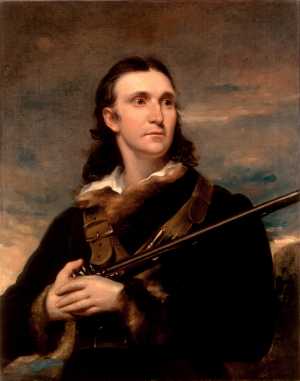 SKC Films Library |
| SKC Films Library >> Science >> Zoology >> Biography |
| John James Audubon painter of birds
John James Audubon was born at Les Cayes, Santo Domingo (now Haiti), on April 26, 1785, the son of Jean Audubon, a sea captain and plantation owner, and his Creole mistress. His mother died soon after his birth, and John was subsequently taken to France, where he was raised by his father's wife; he was legally adopted by them at the age of eight. He was educated in Paris, and also studied painting under J.L. David. Facing conscription into Napoleon's army, Audubon left France in 1803 and settled on his family's estate (called Mill Grove) near Philadelphia. There, he spent much time hunting, watching wildlife, and drawing birds. He also conducted the first known bird-banding experiment in North America -- by tying strings around the legs of Eastern Phoebes, he learned that breeding pairs return to the same nesting sites each year. In 1807, he and Ferdinand Rozier travelled down the Ohio River to Louisville, Kentucky, where they opened a general store. In 1808, he married Mill Grove neighbor Lucy Bakewell, who eventually bore him two sons (Victor Gifford and John Woodhouse) and a daughter who died in infancy. While Rozier took care of day-to-day operations at the store, Audubon wandered the countryside in search of birds to draw. His business career ended in 1819, when he was jailed for debts. He was freed after entering a plea of bankruptcy. Left without an income, he decided to embark on a mission to publish a collection of paintings of American birds. He and his family moved to Louisiana, where Lucy worked as a governess and teacher and John drew portraits and taught music and drawing, when he was home. Between 1820 and 1826, Audubon spent most of his time wandering the wilderness, armed with nothing but a gun and his painting supplies, and amassed an incredible collection of paintings. Unable to find an American publisher for his work, he sailed for England in 1826. His paintings were received with wide acclaim in both England and Scotland, and the first part of his Birds of America was published that same year. By 1838 a total of 87 parts, containing a total of 435 life-sized colored engravings made from his watercolors, had been published. In 1831, he and a Scottish naturalist began collaborating on American Ornithological Biography (1831-1839), consisting of the life histories of every bird depicted in Audubon's paintings. By the time Audubon returned to the United States in 1839, he was financially secure enough to embark on a new mission -- studying and painting North American mammals. The result of this mission was The Viviparous Quadrupeds of North America (1842-1845), which he co-authored with John Bachman. In 1842, he moved his family to an estate on the Hudson River, in New York City, that is now known as Audubon Park. He made his last collecting trip, along the Missouri River, in 1843, and spent the rest of his life in senility. He died on January 27, 1851, and was buried in New York City's Trinity Cemetery. John James Audubon played no part in the founding of the world-famous organization that bears his name (the Audubon Society), but it was named in his honor; George Bird Grinnell, one of its founders, had been tutored by Lucy Audubon and was an ardent admirer of John James Audubon's work. SOURCES |
| SKC Films Library
>> Science >> Zoology >> Biography This page was last updated on 10/08/2017. |
